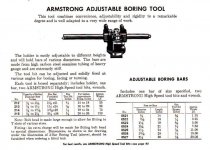Hello again with the questions. I have had this boring bar holder for a few years and I am now going to put it to use after a failed effort due to a small one not being rigid enough for the job. No name on this holder. It will take a 1 3/8 inch bar. Only marking is the cast number 212. No name as per usual. Very strong holder of American manufacture I would think. Any help and guesses will be a great. Thanks, Ted
How to install the app on iOS
Follow along with the video below to see how to install our site as a web app on your home screen.
Note: This feature may not be available in some browsers.
You are using an out of date browser. It may not display this or other websites correctly.
You should upgrade or use an alternative browser.
You should upgrade or use an alternative browser.
Boring Bar Holder I.D.
- Thread starter Ted1928HD
- Start date
- Replies 6
- Views 1,750
thermite
Diamond
- Joined
- Sep 21, 2011
Hello again with the questions. I have had this boring bar holder for a few years and I am now going to put it to use after a failed effort due to a small one not being rigid enough for the job. No name on this holder. It will take a 1 3/8 inch bar. Only marking is the cast number 212. No name as per usual. Very strong holder of American manufacture I would think. Any help and guesses will be a great. Thanks, Ted
Only "guess" I can offer is you don't have any significant boring to do. The lathe and compound UNDER it, it may as well be a McCormack-Deering hay rake.
Research and consider this - I surely ain't the "inventor" of it. Not by 150 years or more.:
- pull the compound rest.
- find or fab a solid monolith Cast Iron or steel "tower".
- mount it directly to the top of the cross slide. Center it.
- Drill the cross for a taper pin you can insert and remove by hand.
- Now drill the tower block from the headstock. Bore it HS to TS center, "line bore" style.
- A bore of 2" that can take recycled turret lathe bushings is good.
- split it for clamping bolts if you forgot to make it two-piece to begin with.
Look around. Folks even sell these, ready-made. Or at least they do/did in England? See "Gibralter".
Now:
Taper-pin IN, you are dead-nuts on-center for drilling with the carriage. No "measuring" required.
Taper-pin OUT you are set up to use boring bars up to two inches with the minimal deflection the cross slide (carriage and bed..) can deliver, CLAMPED if/as/when need be between cutting passes.
Compound is still "elsewhere".
A compound rest only ever WAS an add-on accessory many a serious lathe never saw the arse of in 100 years of hard work.
Not even for single-point threading, given the alternative to a Gibralter-type bar holder is a 4-Way mounted directly to the topslide.
Compounds are for cutting tapers too short and steep for TS setover or a taper attachment.
Not a lot more than that. Rest of the time their primary job is to add slop, flex, and vibration.
2CW
Robert Lang
Stainless
- Joined
- Apr 3, 2007
- Location
- Minneapolis, MN
No name on this holder. It will take a 1 3/8 inch bar. Only marking is the cast number 212. No name as per usual. Very strong holder of American manufacture I would think. Any help and guesses will be a great. Thanks, Ted
It is an Armstrong Bros. Tool Co. of Chicago.
Their No.212.
The 212 is rated for boring bars from 1/4" to 1 5/16".
A 1 5/16" x 21" bar with a 3/8" tool bit would have come with it.
It was rated for lathes with a swing of 14 to 18 inch.
Rob
Hi, just placed that on my lathe to take the picture. I do understand what you mean . Yes, much bigger and more rigid bars are much better. Good idea as you stated. I have done a fair bit or boring on the lathe . It is a South Bend Nordic 15. Usually use a Dorian post with a 1 inch bar with a 432 cnmg bit. Last week bored out some cast iron with a 4 inch hole taking a cut of 1/4 inch for a total removal of 1/2 inch . No problem. But where I ran into a problem was threading a 6 thread per inch. No where as rigid as needed to be and just made a mess. High speed bit in a flexible set up was a disaster. Was not with the Dorian. Your ideas would for sure eliminate the common problems encountered by someone who has had to learn this on the fly. Thanks, Ted
John Garner
Titanium
- Joined
- Sep 1, 2004
- Location
- south SF Bay area, California
Sure looks to me like there is lettering on the clamp's upper surface, in a ring around the toolpost.
ramsay1
Titanium
- Joined
- Aug 19, 2003
- Location
- port allen, louisiana usa
Similar threads
- Replies
- 35
- Views
- 3K
- Replies
- 4
- Views
- 534
- Replies
- 64
- Views
- 3K






